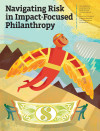 (Illustration by Jean Tuttle)
(Illustration by Jean Tuttle)
Risk is tricky. Aside from the confusing (and sometimes conflicting) definitions and perspectives of risk that are discussed in the following pages—risk as a positive versus negative, risk as a subjective versus objective reality—dealing with risk is easier said than done.
Navigating Risk in Impact-Focused Philanthropy

This special supplement examines the concept of risk in philanthropy, providing insights, examples, and practical steps to help philanthropists better account for and manage risk as an integral part of the grantmaking process.
This is because risk speaks to our core human emotions of fear, hope, skepticism, and confidence. What are you afraid of? What do you trust? And what scares you more, losing money or your reputation? In an environment with scarce resources and no right answers, every choice has trade-offs.
Even in the production of this supplement, we ran into several debates about whether certain examples were “too honest” and could jeopardize relationships; or whether focusing on the role of donors in risk management would push this fundamentally shared responsibility too far off nonprofits’ plates, or ignore the personal agency and ownership of those closest to the work.
In fact, one of the risks with our entire endeavor of making risk “as commonplace in philanthropy as monitoring and evaluation” is that we—unintentionally—do more harm than good. I am personally dreading the day when a nonprofit tells me that a donor asked them to write a five-page risk assessment for a $5,000 grant, in the name of “risk management.”
This supplement makes the express recommendation of policies, protocols, legal frameworks, and scenario planning, to help bring structure and logic to this messy process. Yet, we know that the fundamental success of these tools rests on human elements. Successful relationships, upon which all grantmaking ultimately depends, are impossible without trust. As nearly every article in this supplement notes, trust is hard to create and easy to lose. And the nemesis of trust is fear.
So, if there is one call to action after taking these perspectives into account, it would be to trust a little more and act on fear a little less. Try to be less afraid of telling the truth, asking for help, admitting mistakes. Work to replace doubt with trust and be less afraid of stepping into the unknown. Try accepting—if not embracing—the uncertainty inherent in our work.
By no means has our work on risk management reached its conclusion, and like most systems work, it likely never will. Yet we hope this can be the start of conversation and perhaps even the start of change. After all, when reminded of what we’re facing—poverty, disease, conflict, environmental degradation, human rights abuses, and more—what have we really got to lose?
Support SSIR’s coverage of cross-sector solutions to global challenges.
Help us further the reach of innovative ideas. Donate today.
Read more stories by Maya Winkelstein.

